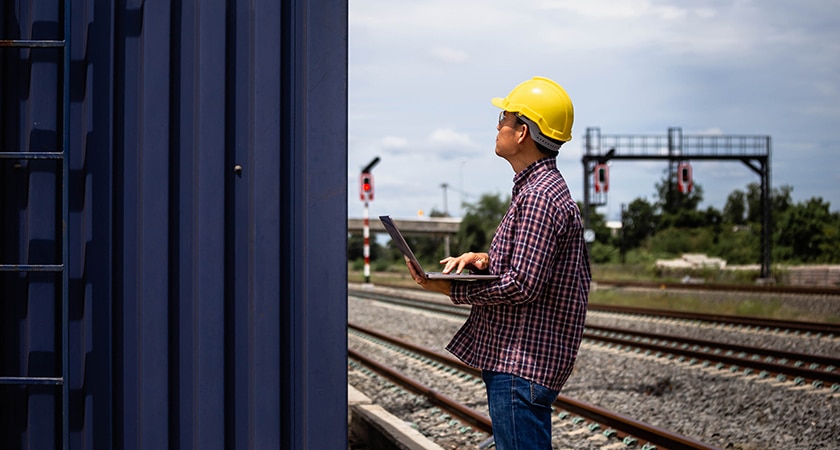
Of all the disciplines and technological fields that support the complex railway operation, probably none has experienced such a rapid and disruptive evolution as telecommunications. However, this transformation that we see applied in many other fields (think of how smartphones have changed our lives) is not yet implemented in railway environments.
However, in recent years, we have already seen how railway operators around the world have begun to consider the evolution of their current networks towards new broadband technologies to support voice services and automatic train control applications, all in accordance with what is described in releases 13 and 14 of the 3GPP (3rd Generation Partnership Project), the entity responsible for the standardisation of broadband technologies on a global level.
In a way, it is logical that within a global context of hyperconnection and digitisation, rail systems should also form part of this process, especially at a time when the train is configured as the great sustainable alternative to road and air travel, with the impetus and support of organisations and governments throughout the world.
Thus, a scenario is emerging in which there are more and more trains, with higher frequencies, faster and faster, with higher levels of automation, more comfortable and safer, offering more services to passengers… For all this, greater transmission capacity is needed, the train of the future needs reliable and secure communications systems that allow the transmission of ever-increasing volumes of data.
In this sense, the current technology used for railway environments in Europe and much of the world, GSM-R, is already facing obsolescence and simply cannot respond to the new requirements of the sector; it does not offer sufficient bandwidth for all those services that transport operators are beginning to incorporate.
Already in the middle of the last decade, and taking into account the rapid evolution of mobile technologies, a debate arose about the advisability of continuing with GSM-R, which was resolved with the realisation that a change of system was necessary and that 5G technology should be the main pillar on which this new system would be built.
Thus, the International Union of Railways (UIC) set to work on defining a mobile communications system for railway environments that, based on 3GPP standards (Release 16), would serve as a replacement for GSM-R as the radio standard for ETCS. Thus FRMCS (Future Railway Mobile Communication System) was born, the system that will technologically mark the evolution of rail transport.
WHAT WILL FRMCS BRING?
As already mentioned, railways currently use the GSM-R standard for operational communication, and it is also a key element of the European ERTMS signalling standard. Designed just over 20 years ago with interoperability as the ultimate goal, GSM-R covers 130,000 kilometres of track in Europe and 210,000 kilometres worldwide.
However, as a second-generation system, it cannot transmit the volumes of data required by the digital train. Additionally, the industry has already announced that 2030 marks the end of its service life.
FRMCS is born with the ambition to replace GSM-R and to provide the capacity to transmit, receive and use increasing volumes of data. In other words, it aims to pave the way for the arrival of the digital train, to be the enabling technology that will support all the applications that arise in the scope of railway digitisation and that will lead to an improvement in the quality of service, intermodality, the introduction of the Internet of Things, and so on. Furthermore, beyond its application for signalling on long-distance lines (the objective of GSM-R), FRMCS aims to become the reference communication system also in urban environments (trams, metros, etc.), offering new functionalities and applications.

In this way, the massive introduction of IoT elements and sensors in both the rolling stock and the infrastructure itself, together with low latencies, will enable maintenance and safety operations to be automated, thus improving the efficiency of the operation.
In short, FRMCS will be the master pillar on which the digitisation of rail is built, optimising costs and processes for rail infrastructure owners and operators, while increasing safety and quality of service levels for all users. It will serve to remove barriers that arise between different transport systems, showing the way towards a new mobility model.
MIGRATION PROCESS
To advance in its definition, the UIC has brought together the main stakeholders from both the rail sector (operators, manufacturers, etc.) and the telecommunications sector (ETSI, 3GPP, industry, etc.) in a collaborative process to design the key elements of the new system.
This must be developed on the basis of global telecommunications standards, in order to have the flexibility that will allow it to remain in place over time and safeguard the investment made by railway operators.
Along these lines, work is being done on 5G technology, so that it is compatible with future generations. Furthermore, it is intended that it can be integrated with complementary systems, such as Wi-Fi, public 5G networks and even satellite networks; it must be based on IP protocols to guarantee optimum capacity for updating applications and, of course, it is absolutely necessary that it allows interoperability, ensuring communication between equipment from different manufacturers and on cross-border routes.
In its development, the UIC has set up several working groups with high levels of expertise dealing with different areas, from specifications and frequencies, to how migration processes should be. In addition, around a hundred use cases have been studied and are in the process of standardisation.

Although the first tests have already started, according to experts’ forecasts, the first migrations from GSM-R to FRMCS are expected to take place between 2025 and 2035. It will be a system based on 3GPP Release 17 and the UIC is working to make all services available.
As Jean Michel Evanghelou, deputy director of Rail Sistem and director of Telecom, Signalling and Digital Applications at the UIC, explains, it will be a very complex transition process, in which all the actors involved will have to manage functional requirements, standardisation issues, applications and, finally, aspects related to frequency bands and radio spectrum.
Initially, as Evanghelou points out, European frequency harmonisation has already been necessary for all countries to use the same spectrum band. This is only a first milestone among the changes to be undertaken in four areas: the interior design of trains, radio space, signalling systems and the temporary coexistence between GSM-R and FRMCS.
It is therefore a complex process, but one whose final benefits will result in more efficient, safer and more sustainable rail transport.


